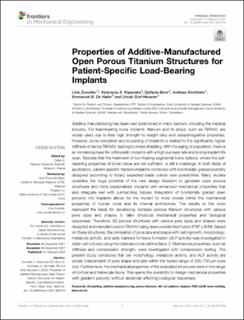Bitte benutzen Sie diese Kennung, um auf die Ressource zu verweisen:
https://doi.org/10.21256/zhaw-24157| Publikationstyp: | Beitrag in wissenschaftlicher Zeitschrift |
| Art der Begutachtung: | Peer review (Publikation) |
| Titel: | Properties of additive-manufactured open porous titanium structures for patient-specific load-bearing implants |
| Autor/-in: | Zumofen, Livia Kopanska, Katarzyna S. Bono, Epifania Kirchheim, Andreas De Haller, Emmanuel B. Graf-Hausner, Ursula |
| et. al: | No |
| DOI: | 10.3389/fmech.2021.830126 10.21256/zhaw-24157 |
| Erschienen in: | Frontiers in Mechanical Engineering |
| Band(Heft): | 7 |
| Heft: | 830126 |
| Erscheinungsdatum: | Feb-2022 |
| Verlag / Hrsg. Institution: | Frontiers Research Foundation |
| ISSN: | 2297-3079 |
| Sprache: | Englisch |
| Schlagwörter: | 3D printing; Additive manufacturing; Porous titanium; 3D cell culture; Implant; PBF-LB/M; Laser melting; Biomaterial |
| Fachgebiet (DDC): | 610.28: Biomedizin, Biomedizinische Technik 670: Industrielle und handwerkliche Fertigung |
| Zusammenfassung: | Additive manufacturing has been well established in many sectors, including the medical industry. For load-bearing bone implants, titanium and its alloys, such as Ti6Al4V, are widely used due to their high strength to weight ratio and osseointegrative properties. However, bone resorption and loosening of implants is related to the significantly higher stiffness of dense Ti6Al4V, leading to stress shielding. With the aging of population, there is an increasing need for orthopedic implants with a high success rate and a long implant life span. Besides that the treatment of non-healing segmental bone defects, where the self repairing properties of bone tissue are not sufficient, is still a challenge. In both fields of application, patient-specific titanium implants combined with functionally graded porosity designed according to locally expected loads unlock new possibilities. Many studies underline the huge potential of the new design freedom to generate open porous structures and more personalized implants with enhanced mechanical properties that also integrate well with surrounding tissues. Integration of functionally graded open porosity into implants allows for the implant to more closely mimic the mechanical properties of human bone and its internal architecture. The results of this work represent the basis for developing complex porous titanium structures with various pore sizes and shapes to tailor structural mechanical properties and biological responses. Therefore, 3D porous structures with various pore sizes and shapes were designed and manufactured in Ti6Al4V using laser powder bed fusion (PBF-LB/M). Based on these structures, the correlation of pore size and shape with cell ingrowth, morphology, metabolic activity, and early markers for bone formation (ALP activity) was investigated in static cell cultures using the osteosarcoma cell line Saos-2. Mechanical properties, such as stiffness and compression strength, were investigated with compression testing. The present study concludes that cell morphology, metabolic activity, and ALP activity are widely independent of pore shape and size within the tested range of 400–700 µm pore size. Furthermore, the mechanical properties of the evaluated structures were in the range of cortical and trabecular bone. This opens the possibility to design mechanical properties with gradient porosity without decisively affecting biological responses. |
| URI: | https://digitalcollection.zhaw.ch/handle/11475/24157 |
| Volltext Version: | Publizierte Version |
| Lizenz (gemäss Verlagsvertrag): | CC BY 4.0: Namensnennung 4.0 International |
| Departement: | Life Sciences und Facility Management School of Engineering |
| Organisationseinheit: | Institut für Chemie und Biotechnologie (ICBT) Institute of Product Development and Production Technologies (IPP) |
| Enthalten in den Sammlungen: | Publikationen School of Engineering |
Dateien zu dieser Ressource:
| Datei | Beschreibung | Größe | Format | |
|---|---|---|---|---|
| 2022_Zumofen-etal_Properties-load-bearing-implants_FrontMech.pdf | 2.26 MB | Adobe PDF |  Öffnen/Anzeigen |
Zur Langanzeige
Zumofen, L., Kopanska, K. S., Bono, E., Kirchheim, A., De Haller, E. B., & Graf-Hausner, U. (2022). Properties of additive-manufactured open porous titanium structures for patient-specific load-bearing implants. Frontiers in Mechanical Engineering, 7(830126). https://doi.org/10.3389/fmech.2021.830126
Zumofen, L. et al. (2022) ‘Properties of additive-manufactured open porous titanium structures for patient-specific load-bearing implants’, Frontiers in Mechanical Engineering, 7(830126). Available at: https://doi.org/10.3389/fmech.2021.830126.
L. Zumofen, K. S. Kopanska, E. Bono, A. Kirchheim, E. B. De Haller, and U. Graf-Hausner, “Properties of additive-manufactured open porous titanium structures for patient-specific load-bearing implants,” Frontiers in Mechanical Engineering, vol. 7, no. 830126, Feb. 2022, doi: 10.3389/fmech.2021.830126.
ZUMOFEN, Livia, Katarzyna S. KOPANSKA, Epifania BONO, Andreas KIRCHHEIM, Emmanuel B. DE HALLER und Ursula GRAF-HAUSNER, 2022. Properties of additive-manufactured open porous titanium structures for patient-specific load-bearing implants. Frontiers in Mechanical Engineering. Februar 2022. Bd. 7, Nr. 830126. DOI 10.3389/fmech.2021.830126
Zumofen, Livia, Katarzyna S. Kopanska, Epifania Bono, Andreas Kirchheim, Emmanuel B. De Haller, and Ursula Graf-Hausner. 2022. “Properties of Additive-Manufactured Open Porous Titanium Structures for Patient-Specific Load-Bearing Implants.” Frontiers in Mechanical Engineering 7 (830126). https://doi.org/10.3389/fmech.2021.830126.
Zumofen, Livia, et al. “Properties of Additive-Manufactured Open Porous Titanium Structures for Patient-Specific Load-Bearing Implants.” Frontiers in Mechanical Engineering, vol. 7, no. 830126, Feb. 2022, https://doi.org/10.3389/fmech.2021.830126.
Alle Ressourcen in diesem Repository sind urheberrechtlich geschützt, soweit nicht anderweitig angezeigt.